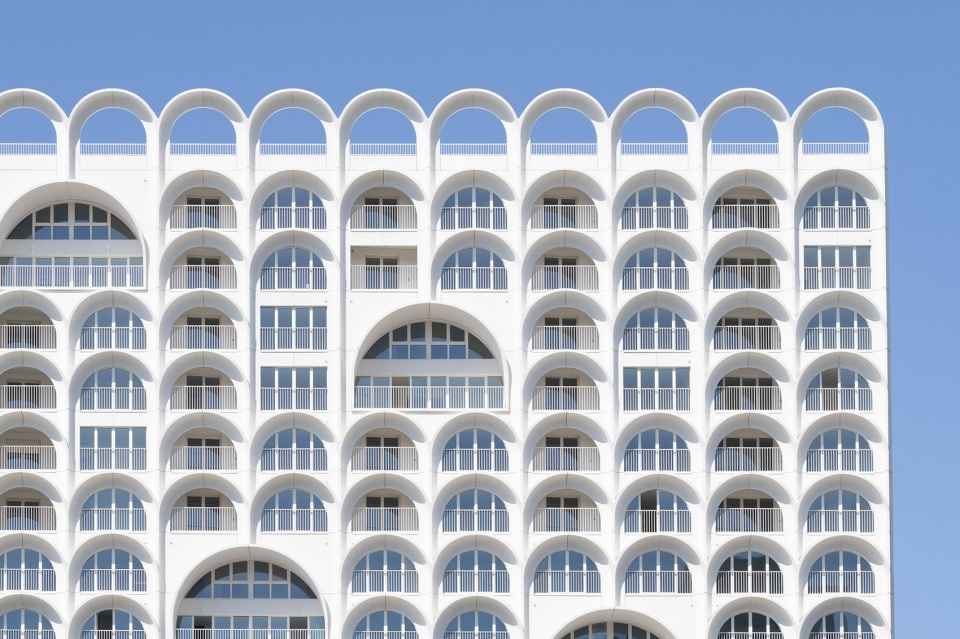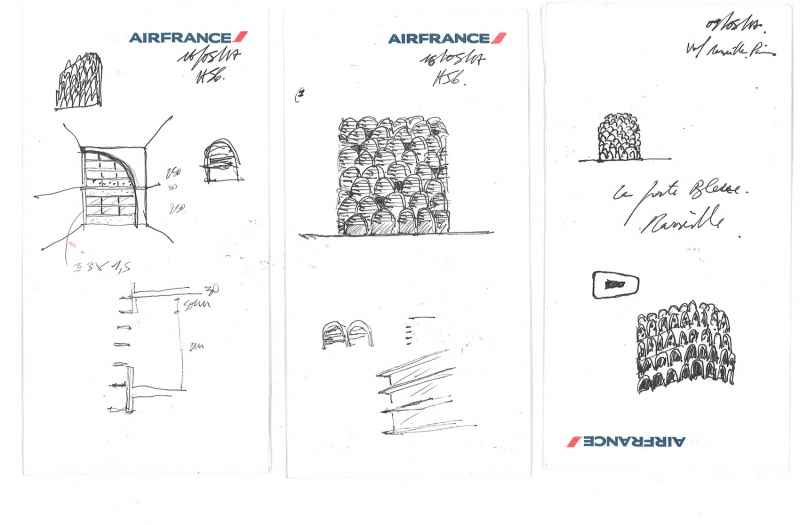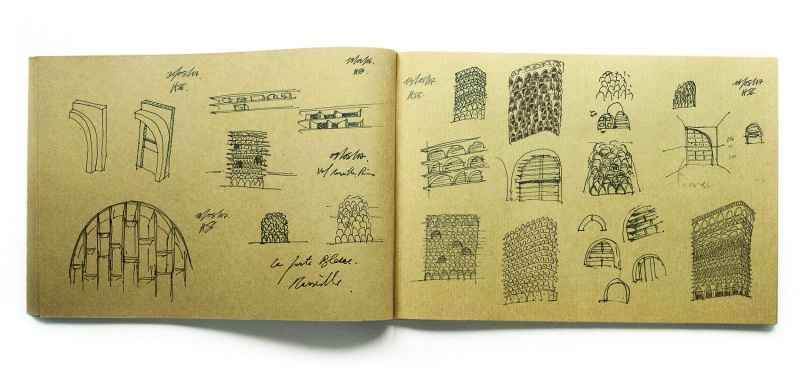来源:谷德设计网
如有侵权,请联系删除

“蓝色大门”项目于2023年9月在法国马赛落成。这是Pietri建筑设计事务所里程碑式的项目。该建筑的立面由414个圆拱组成,创造了一种面向地中海的诗意的建筑语言。建筑坐落于马赛的Euromédi- terranée地区,也成为了马赛地区的新标志,大楼内包含供旅游者居住的酒店和普通住宅单元。
The month of September 2023 opened inMarseille with an event: the delivery of the Porte Bleue. This is the flagship project of the Pietri Architectes agency. The facade is made up of 414 vaults opening the view onto the Mediterranean in a subtle architectural poetry.Located in the Euromédi- terranée district, the Porte Bleue is a new emblem of Marseille, housing a tourist residence and residential units.
▼建筑概览,building overview © Luc Boegly
当我们谈起马赛,脑海中会浮现这样的画面:大海,山川,旧港口,Canebière,Mucem等等。不仅如此,马赛也是法国历史最悠久的城市之一,基于这座城市的人口与港口历史,它也在不久前仍被称为“通往东方的大门”。这个项目也是城市多元组成的寓言。它不仅仅是一座建筑,更是希望能借由建筑实现在Arenc码头对马赛这座城市的颂歌。首先,必须从其地理位置的性质中寻找项目的精华。从地理位置上看,“蓝色大门”位于城市的标志性十字路口:进城的车辆在此交汇,出城的车辆也在此交汇,乘客和货物在此上下船。这里真正建立了港口、道路和城市之间的联系。它是城市区域与外部区域的交叉点。从这个意义上说,它是城市的门户之一,而正是这一特点在很大程度上指导了项目的实施。
When we talk about Marseille, several images come to mind: the sea, the hills, the old port, the Canebière, the Mucem…But Marseille is also a history of the oldest city in France, the history of a population and a port which was described, not so long ago, as the “Gateway to the Orient”. The project in question here is an allegory of the multiple components of the city. More than a building, it is an ode to the Marseille city that we wish to materialize within the Quais d’Arenc. Firstly, the essence of the project must be sought in the nature of its location. By its geographical position, the Porte Bleue is located at an emblematic crossroads of the city: the one where the vehicles which enter the city cross those which leaveit, the one where the boats disembark and embark the passengers and the cargoes. This place truly establishes theconnection between the port, the roads and the city. It is a crossing point between the urban area and its exterior. In this sense, it stands out as one of the city’s gateways and it is this characteristic feature which largely guided the project.
▼周围交通环境,traffic situation around the building © Luc Boegly
但如果只谈论项目的地理位置的话,就像谈论马赛却不谈论马赛的人民,马赛人独特的口音,南方人特有的温暖和他们多元的起源。这就等于忽视了项目的一个重要组成部分:使这座建筑成为城市几个世纪以来 “共同生活 “的象征的愿景。马赛是一个多元族群共同构成的城市。对于异乡人的到来表示欢迎是这里传承了几个世纪的传统,也是这座城市的根源。马赛不是由希腊人建立,然后被罗马人改造,最后成为普罗旺斯人的城市,再成为法国人的城市吗?事实证明,自近代以来,马赛一直是跨地区移民和国际移民所带来的劳动力的聚集地。它不仅仅是一座城市,也是被本国的独裁政权驱逐或因贫困潦倒而逃离的难民的避难所,包括意大利人,西班牙人,亚美尼亚人和北非人…….大多数人都最终在这里安家。今天的马赛是如同由各种文化组成的马赛克,它们相互依存,相互感激。由于其丰富的多样性,这座城市就像一扇向世界敞开的大门。
But reducing the Porte Bleue to its location would be like talking about Marseilles without mentioning the people of Marseilles, their particular accent, their southern warmth and their varied origins. This would amount to ignore an essential component of the project: the desire to make this building a symbol of the “living together ” that has reigned in the city for centuries. Indeed, Marseille is a city where different communities mix. Welcoming newcomers is a local tradition that has been anchored for centuries, a tradition that has its roots in the origins of the city. Wasn’t Marseille founded by the Greeks then reinvented by the Romans, before becoming Provençal then French? Isn’t it proven that the city has been, since modern times, the receptacle of a workforce resulting from inter-regional and then international migrations? More than a city, Marseille has often been a refuge for populations driven out of their regions by authoritarian regimes or by poverty: Italians, Spaniards, Armenians, North Africans… All have found refuge there, and many have ended up to make a home there. Marseille today is a mosaic of cultures living side by side, with each other, and thanks to each other. Thanks to its tremendous diversity, the city appears as an open door to the world.
▼周围环境,surroundings © Luc Boegly
从建筑学上来说,该项目看起来像是由多个自支撑的混凝土圆拱构成的石碑。多亏了这些圆拱,从建筑内部也可以通过弧形的视野看到远处的风景。通过这个房地产项目,马赛有机会获得一座标志性的建筑,它将成为文化大熔炉,使马赛成为一座独一无二的城市。立面上的圆拱互相依靠像构成一幅完整拼图的多个元素,每一片都缺一不可。蓝色大门项目是对这座城市根源的真正的致敬。此外,该建筑的结构也反映了其地理位置的实际情况:许多拱顶就像许多门,连接了建筑的内部和外部。最后,不仅仅用比喻来总结,拱顶作为建筑立面的元素,将该建筑与犹太-基督教文明的历史联系在一起,而犹太-基督教文明本身又借鉴了希腊-罗马文明的遗迹。
Architecturally, the project appears as a monolith composed of a multitude of self-supporting concrete vaults. Thanks to them, from inside the building, the exterior landscape can be seen through a curve. With this real estate project, Marseille has the opportunity to acquire an emblematic building which would materialize the melting pot of cultures that make it a unique city. Through its vaults which lean on each other like so many elements that make up a puzzle and which could not exist without each other, The Porte Bleue appears as a true homage to the roots of the city. Moreover,the architecture of the building also reflects the reality of its geographical location: the many vaults are so many doors,therefore connections between the inte- rior and the exterior of the building. Finally, let us emphasize that more than a metaphor, the use of the vaults as a façade element links the building to the history of our Judeo-Christian civilization, itself borrowing from the remains of the Greco-Roman civilization.
▼由多个自支撑的混凝土圆拱构成立面,facade composed of a multitude of self-supporting concrete vaults © Luc Boegly
Pietri建筑事务所在2016年至2017年就开始设计蓝色大门项目,它是一个包括4栋截然不同的建筑体量的房地产开发项目(办公、住宅和商店)的一部分,是 ZAC Euroméditerra-ée 整体开发项目的核心。该项目是港口、道路和城市之间真正的连接点,是马赛的门户之一。
▼整个地块由四栋建筑构成,site composed with four distinct buildings © Pietri Architectes
La Porte Bleue is under design since 2016-2017 by Pietri Architectes, it is part of a real-estate program of 4 distinct buildings (offices, housing and shops) at the heart of the overall development operation of the ZAC Euroméditerra- née. The project represents a true place of connection between the port, the roads and the city, it embodies one of the gateways to Marseille.
▼整个地块构成,site composition © Luc Boegly
想象之门
A door to the imagination
蓝色之门的拱顶象征着马赛和地中海沿岸的每个起源。让-巴蒂斯特-皮埃特里(Jean-Baptiste Pietri)受此启发,提出了一种通过他的哲学分析来反映这种遗产的建筑学类型: 浪漫理性主义。
▼草图设计,sketch design © Pietri Architectes

The vaults of the Porte Bleue are the symbol of each origin found in Marseille and borders the Mediterranean.The Phocaean city is a mosaic of cultures, Jean-Baptiste Pietri was inspired by this to propose an architecture which reflects this heritage analyzed through his philosophy: Romantic Rationalism.
▼立面构成,facade composition © Lisa Ricciotti
“蓝色大门”的设计灵感来源于很多的参考意向,有一些参考很清晰如罗马意大利文明宫的拱顶,尽管它已成为历史,但仍是许多建筑师的灵感源泉。以及Pietri建筑事务所修复的马赛少校宫的拱顶。城市入口大门的整体外观,被塔楼的体量环绕的纪念碑般的入口。其他灵感则来自地中海沿岸的建筑,如Amalfi 海岸建筑美丽的装饰拱顶。
▼草图设计,sketch design © Pietri Architectes

The design of the Porte Bleue draws on numerous references, they are sometimes clear like the vaults of the Palace of Italian Civilization in Rome, an inspiration for many architects despite its past, the vaults of the Major in Marseille rehabilitated by Pietri Architectes or the monolithic appearance of a city entrance gate, a monumental threshold embodied by the volume of the tower. Other inspirations come from the architecture bordering theMediterranean, such as the Amalfi Coast and the beautiful vaults which adorn the buildings.
▼由多个圆拱组成的立面,facade composed with various arches © Luc Boegly
该项目的模式采用了圆拱作为一种地中海元素和建筑的关键组成部分。这也是向遥远东方的致敬,因为这座城市的历史与东方的国度颇有渊源。不同于其他项目,该建筑的立面抓住了马赛标志性的光照,混凝土在一天中的不同时间呈现不同的光影变化。圆拱的白色是Pietri 建筑事务所的标志,是对地中海和石灰石颜色的一种借鉴….该事务所的许多项目都采用了白色,如 Bains de Mer Chauds 项目,其颜色极具海滨风情和环境特色。白色也代表现代建筑和太阳能建筑的颜色,是蓝色大门的完美特征。
The modenature of the project uses the vault as a Mediterranean element and a key marker of the architecture. It’s also a nod to the Orient, to which the city’s history brings it so close. The façade catches Marseille’s characteristic light like no other, and the concrete illuminates according to the time of day. The white of the vaults, a true Pietri Architectes signature, is a reference to the Mediterranean, to the color of limestone…. White is found in many of the agency’s projects, such as the Bains de Mer Chauds, whose color is extremely seaside and contextual. White is also the color of modernity and solar architecture, which perfectly characterizes La Porte Bleue.
▼白色混凝土的光影变化,the white concrete illuminates according to the time of day © Lisa Ricciotti
Arenc码头:城市新动力
The Quays of Arenc: a new dynamic for the city
作为马赛的新中心,Arenc区在过去的20年里不断发展。在19世纪这里是海边的目的地,然后成为港口的船坞,最近这些年它的发展开始进入新的阶段,通过 Mucem 和 Silo 音乐厅,Arenc区成为一个有吸引力的文化区。当代的Arenc不仅仅是法国第三大的商业区,也是坐拥马赛最壮丽风景的住宅区,离地中海仅一步之遥。
The new center of Marseille, the Arenc district has been constantly evolving over the past 20 years. A seaside destination in the 19th century, then a port hub, in recent years the quays of Arenc have entered a new phase in their history, becoming an attractive cultural district thanks to the Mucem and the Silo concert hall. Today, Arenc is not only France’s 3rd-largest business district, but also a residential area with one of the most spectacular views in Marseille, just as tone’s throw from the Mediterranean.
▼Arenc区已成为马赛的新中心,the Arena district has became the new center for Marseille © Lisa Ricciotti
蓝色大门是组成这个新区活力的一部分,它提供的四星级旅游酒店现在属于 Odalys,是该酒店集团的新标志。这座塔楼同样提供可售卖的住宅公寓和一层朝南面对马赛港口的零售商店。不管是古董店、咖啡店还是小超市,都会成为广场和前院的连接点。一个独立的餐厅从主建筑中伸出,它的三面玻璃幕墙和绿植屋顶又为室内空间增添了活力。有了这些业态的扶持,游客们可以随时“入住”Arenc码头。
La Porte Bleue is part of the dynamism of this new district by offering a 4-star tourist residence now belonging to Odalys as a new emblem of the tourist accommodation group. The tower also offers housing for home buying and features a retail outlet on the first floor to the south, facing the Docks de Marseille. Whether it’s a boutique, café or mini-market, it will act as a junction between the square and the forecourt. An independent restaurant, projecting from themain volume, will in turn energize this interiority with its 3 glass façades and planted roof. Arenc can be «lived in» at any time.
▼项目近景,project closer view © Lisa Ricciotti
建造者的故事
A story of builders
这是一个特殊的故事。对于这个项目而言,客户和建筑师之间的关系是特别的。Jean-Baptiste Pietri,作为Pietri建筑事务所的建筑师,在他的父亲Marc Pietri突然去世后,他不得不于2020 年接手家族企业Constructa建筑公司,并因而负责公司的项目管理。Jean-Baptiste Pietri因此身兼两角:他既是项目的建筑师又是项目的拥有者,这位 “走钢丝的人 “在他的宝贵团队的帮助下,成功地应对了这一局面。这个项目的故事是由Pietri建筑事务所和Constructa建筑公司共同完成的。这两家公司共同完成了蓝色大门项目。
It’s a special story. The relationship between the client and the architect is unusual for this project. Jean-Baptiste Pietri, architect of Pietri Architectes, had to take over the reins of the family firm Constructa in 2020, and thus of the project management, following the sudden death of his father Marc Pietri. Jean-Baptiste Pietri therefore wears two hats:architect and project owner, a situation that this tightrope walker is able to manage with the help of his invaluable teams.The story of this project is one of builders, PietriArchitectes on the one hand, and Constructa on the other. The twoentities were able to bring La Porte Bleue to completion.
▼项目街景,project street view © Luc Boegly
该项目以其在建筑上的雄心勃勃而脱颖而出,为马赛创造了体现其价值观的标志性大楼。蓝色大门项目的特征是大胆创新。一开始,项目所在的场地是为了容纳另一座纤细的垂直塔楼的,但是Constructa最终决定修建一座更小的塔楼,并将该项目交给了Pietri建筑事务所。因而蓝色大门项目符合«4th family»的标准;因防火要求,建筑的最高高度不得超过50米。该项目还必须利用现有的限制条件,将自己定位在以前建造的地下停车场上,以及前项目的主管道和地基上。这些困难并没有绊住建筑师Jean-Baptiste Pietri的脚步,项目保留了之前建筑的痕迹,并在其基础上建造了蓝色大门。室内体量沿用了停车场的矩形网格,然后在私人公寓层打破了这一格局,消弥了布局的单调。蓝色大门的设计体现了垂直平行六面体的体积感。因此,Pietri建筑师事务所宁可选择设计一座单体塔楼,也不愿意受这种令人联想到 20 世纪 60 年代建筑的难看形态的影响。
The project stands out for its architectural ambition and offers Marseille a new symbol that embodies its values. The Porte Bleue project is characterized by its boldness. Initially, the project site was to accommodate another slender,vertical tower, but Constructa decided to build a smaller tower and entrust its construction to Pietri Architectes. In this way, Porte Bleue meets the criteria of the «4th family», whose buildings must not exceed 50 meters in height at the last floor, for fire safety reasons. The project also had to take advantage of an existing constraint by positioning itself on a previously built underground parking lot, there mains and foundations of the previous project.These difficulties did not, however, hinder architect Jean-Baptiste Pietri, whose project takes on the traces of the previous building and guided the construction of Porte Bleue. The interior volumes follow the rectilinear grid of the parking lot, then break away from this pattern at the level of the private apartments to break the monotony. The design of Porte Bleue offers a volumetry that embodies a vertical parallelepiped. Consequently, rather than suffer from this unsightly morphology which recalls the architecture of the 1960s, Pietri Architectes preferred to imagine the best use that could be made of this size by designing a singular tower.
▼大胆创新的立面,the facade is characterized by its boldness© Lisa Ricciotti
圆拱的诗意:优雅与技术
The poetry of vaults:between elegance and technique
立面由众多相互倚靠的圆拱构成。圆拱必须符合严格的规格要求,并选用对环境影响较小的混凝土,这种混凝土是在马赛附近的Aubagne镇当地制造的。这些混凝土的装饰元素为塔楼带来了像树一样的设计,也成为了一个标志,一件作品的真正签名。套房和复式套房的双层大圆拱在外立面上创造出各种变化,引起路人的好奇。圆拱的立面元素像柔软简单的取景框框住窗外的风景。这些混凝土圆拱由铝合金连接,构成防水的外立面。这些圆拱厚约90cm,它们还在保护居民免受风吹日晒方面发挥着重要作用,同时又不会剥夺他们享受宽敞视野的权利。蓝色大门项目拥有占比50的玻璃立面和开放式窗户,为住户带来非凡的生活品质。
▼立面爆炸图,facade exploded diagram © Pietri Architectes
The facades of the project are made up of a multitude of vaults leaning on each other. The vaults had to meet strict specifications with the choice of a concrete with a lower environmental impact shaped locally in the town of Aubagne, a town close to Marseille. This concrete adornment gives the tower a particular tree-like design that has become a marker, a real signature of the work. The large double-height vaults housing the suites and duplexes create events in the facade and arouse the curiosity of passers-by. The rounded shapes of the vaults frame the landscape in a soft and singular way through a curve from each interior space. These concrete vaults contribute to the waterproofing of the exterior envelope, in concert with the aluminum joinery. With their 90 cm deep cap, they also play an important role in protecting residents from the wind and the sun without depriving them of generous glazing. La Porte Bleue has 50% glass surface and opening windows for an exceptional quality of life.
▼大胆创新的立面,the facade is characterized by its boldness © Lisa Ricciotti
低碳混凝土和海洋地热能
Low-carbon concrete and marine geothermal energy
Pietri建筑事务所和Masse建筑事务所(负责结构和立面设计)一起设计了该项目标志性的立面。这414个圆拱由多个90cm厚的Y形模块组成,它们通过浇铸的梁和板相连接,从而构成了大楼的支撑元素。
▼立面Y形模块,Y-shaped modules © Pietri Architectes
Pietri Architectes and Atelier Masse (structure and facade design office) developed the iconic facade of this project. The 414 vaults are made up of various 90 cm thick Y-shaped modules, linked by keys to the cast beams and slabs and thus constitute a supporting element of the project.
▼Y形模块完成效果,final results of Y-shaped modules © Luc Boegly
场外的圆拱的制造始于地中海制造公司(Méditerranée Préfabrication company)的工坊。在这一过程中,通过开发 13 个不同的模块,拱顶的设计变得更加完美,立面的表达也更为自由。执行速度也是该项目的一大优势。为了防止工坊的组件堆积,每一个组件都需要及时持续的送达场地。再利用塔吊将圆拱一个个吊起。特别是由于地形狭小,这项工作需要现场施工队的高超技艺,但他们还是克服了这一挑战。
Off-site manufacturing of the vaults begins in the workshop of the Méditerranée Préfabrication company. This process made it possible to perfect the creation of the vaults with the development of 13 different modules and freedom in the expression of the facade. The speed of execution was also an asset. Each part had to be delivered to the La Porte Bleue site in continuous flow in order to prevent congestion on the two sites which could not store the elements. The vaults were then, one after the other, placed using a crane. This operation required great dexterity from the site teams due, in particular, to the smallness of the terrain, but the challenge was met.
▼Y形模块施工过程,construction of Y-shaped modules © Michele Clavel
▼塔吊移动模块,using crane to place the modules © Jean Baptiste Pietri
建筑师要求高质量的,颜色明确的混凝土。然而挑战在于找到一种持久耐用且同样有美感的材料。有两种选择:玄武岩纤维不饱和聚酯树脂(basalt fiber unsaturated polyester)和钢筋混凝土。建筑师最终选择了高曝光的白色钢筋混凝土来对抗因靠近大海带来的腐蚀,厚度较薄的拱顶带来较大的阻力。选择混凝土的最后一个要点是,既要满足可持续发展的挑战,又要保持其性能和耐久性。基于这一原因,Vinci建造(Vinci Construction)和地中海制造公司(Méditerranée Préfabrication)和另一个子公司一起研发了一种低碳混凝土来降低对环境的影响。这一由414个圆拱组成的自支撑立面创造了一种整体性的成果,通过美学、技术和建筑设计,将诗意的维度融为一体。
The architect required a high quality of concrete and a very precise color; the challenge was to find a material that was both durable and resistant, but also aesthetic. Two options were possible, BFUP or reinforced concrete. The choice fellon a white reinforced concrete with a higher exposure class to combat corrosion due to the proximity of the building to the sea, but also of great resistance to have a thin thickness of the vaults. The last important point in the selection of concrete concerned a material meeting the challenges of sustainable development while retaining its performance and resistance qualities. For this, Vinci Construction and Méditerranée Préfabrication, a subsidiary, have developed low-carbon concrete to reduce environmental impact. This self-supporting facade made up of 414 vaults gives a monolithic result which combines a poetic dimension through its aesthetics and technical and architectural prowess.
▼圆拱组成的整体性的立面,the monolithic facade made up of vaults © Luc Boegly
蓝色大门全面致力于可持续发展问题。就像它的邻居,由让.努维尔设计的Tour La Marseillaise,以及其他欧洲地中海地区的建筑,蓝色大门与 “Thassalia ”装置相连,可以利用海洋地热能为大楼提供供暖和空调,采用了清洁能源方面最先进的工艺。
La Porte Bleue is fully committed to sustainable development issues. Like its neighbor the Tour La Marseillaise, designed by Jean Nouvel, and other buildings in the Euro méditerranée district, it is connected to the “Thassalia”installation which allows the building to be heated and air-conditioned using the marine geothermal energy, a state-of-the-art process in terms of clean energy.
▼通风良好的室内环境,well-ventilated interior space © Pierre Louis Leclercq
一分为二
One project, two entities
在这一总高53米的建筑内,分成了两个部分。第一个部分是位于较低的11层,共包含250个豪华装修套房的4星级旅游酒店,考虑到游客们的需求还配备了一个室内游泳池及其他设施,餐厅和接待区域也使整个酒店更加完善。第二个部分是位于较高的7层占地共4891m²的69个公寓单元。公寓不仅立面美观而且视野开阔。设计的目的之一就是为所有的住户提供宽敞的阳台,在阳台上可以尽情俯瞰西面的大海以及东面和南面的马赛市。这些阳台可以被看作是起居室的额外空间。一系列的房间组成了这座塔楼:从12层到16层的提供 T1 至 T4 的单间,在最高两层17层和18层提供 T3 至 T4 的复式套房。
Within a 53-meter-high building, two entities make up the program. The first is a 4-star tourist residence on the 11 lower levels comprising 250 units with refined decor, but also a space dedicated to well-being with the presence of an indoor swimming pool and other equipment dedicated to this purpose, a restaurant and reception areas complete the whole. The second, built on the last 7 levels, is made up of 68 housing units for a total floor area of 4,891 m². The latter offer beautiful surfaces and an unobstructed view. The decision was to provide all the accommodation with large loggias where previously unseen views are revealed over the sea to the west and over the city of Marseille to the east and south. These loggias can be considered as additional open living rooms. A wide range of housing makes up the tower: simplex housing ranging from T1 to T4 on levels R+12 to R+16, duplex housing ranging from T3 to T4 are offered on the last 2 levels (R+17 and R+ 18).
▼室内环境,interior space © Luc Boegly
▼项目场地模型,site model within buildings © Pietri Architectes
▼平面图,plan © Pietri Architectes
▼立面图 1,elevation 1 © Pietri Architectes
▼立面图 2,elevation 2 © Pietri Architectes
▼立面构件分析,facade elements analysis © Pietri Architectes
Location: Marseille, Provence-Alpes-Côte-d ’Azur, France
Project: Construction d’une résidence de tourisme 4 étoiles et de logements en accession
Architecte: Pietri Architectes
Principal architect: Jean-Baptiste Pietri
Associated architects: Jérémy Louette, Marine de Chateauneuf, Zoé Reynaud
Team: Julie Mazière, Clémence Goix, Juane Ferrer, Hugo Chauwin, Auriane Bonnault, Yann Courteille
Client: Constructa — Les Éditeurs Urbains team Constructa: Nicolas Sanchez, Alice Bôl, Anthony Serra
Completion: 2023
Graphic designer: Marie Philippe
TechnicaL engineering agency: BET Yves Garnier
StructuraL engineer: BET Masse
Area: 13 000 m²
Cost: 26 M€
Design Phase: since 2016-2017